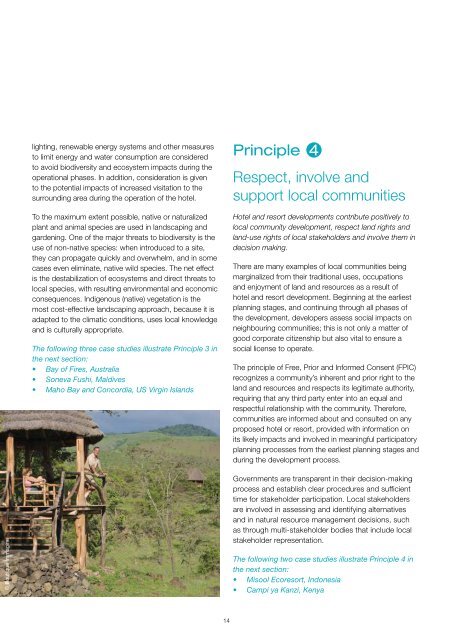Siting and Design of Hotels and Resorts: Principles - IUCN
Siting and Design of Hotels and Resorts: Principles - IUCN
Siting and Design of Hotels and Resorts: Principles - IUCN
Create successful ePaper yourself
Turn your PDF publications into a flip-book with our unique Google optimized e-Paper software.
© Boutique Immagine<br />
lighting, renewable energy systems <strong>and</strong> other measures<br />
to limit energy <strong>and</strong> water consumption are considered<br />
to avoid biodiversity <strong>and</strong> ecosystem impacts during the<br />
operational phases. In addition, consideration is given<br />
to the potential impacts <strong>of</strong> increased visitation to the<br />
surrounding area during the operation <strong>of</strong> the hotel.<br />
To the maximum extent possible, native or naturalized<br />
plant <strong>and</strong> animal species are used in l<strong>and</strong>scaping <strong>and</strong><br />
gardening. One <strong>of</strong> the major threats to biodiversity is the<br />
use <strong>of</strong> non-native species: when introduced to a site,<br />
they can propagate quickly <strong>and</strong> overwhelm, <strong>and</strong> in some<br />
cases even eliminate, native wild species. The net effect<br />
is the destabilization <strong>of</strong> ecosystems <strong>and</strong> direct threats to<br />
local species, with resulting environmental <strong>and</strong> economic<br />
consequences. Indigenous (native) vegetation is the<br />
most cost-effective l<strong>and</strong>scaping approach, because it is<br />
adapted to the climatic conditions, uses local knowledge<br />
<strong>and</strong> is culturally appropriate.<br />
The following three case studies illustrate Principle 3 in<br />
the next section:<br />
• Bay <strong>of</strong> Fires, Australia<br />
• Soneva Fushi, Maldives<br />
• Maho Bay <strong>and</strong> Concordia, US Virgin Isl<strong>and</strong>s<br />
14<br />
Principle<br />
4<br />
Respect, involve <strong>and</strong><br />
support local communities<br />
Hotel <strong>and</strong> resort developments contribute positively to<br />
local community development, respect l<strong>and</strong> rights <strong>and</strong><br />
l<strong>and</strong>-use rights <strong>of</strong> local stakeholders <strong>and</strong> involve them in<br />
decision making.<br />
There are many examples <strong>of</strong> local communities being<br />
marginalized from their traditional uses, occupations<br />
<strong>and</strong> enjoyment <strong>of</strong> l<strong>and</strong> <strong>and</strong> resources as a result <strong>of</strong><br />
hotel <strong>and</strong> resort development. Beginning at the earliest<br />
planning stages, <strong>and</strong> continuing through all phases <strong>of</strong><br />
the development, developers assess social impacts on<br />
neighbouring communities; this is not only a matter <strong>of</strong><br />
good corporate citizenship but also vital to ensure a<br />
social license to operate.<br />
The principle <strong>of</strong> Free, Prior <strong>and</strong> Informed Consent (FPIC)<br />
recognizes a community’s inherent <strong>and</strong> prior right to the<br />
l<strong>and</strong> <strong>and</strong> resources <strong>and</strong> respects its legitimate authority,<br />
requiring that any third party enter into an equal <strong>and</strong><br />
respectful relationship with the community. Therefore,<br />
communities are informed about <strong>and</strong> consulted on any<br />
proposed hotel or resort, provided with information on<br />
its likely impacts <strong>and</strong> involved in meaningful participatory<br />
planning processes from the earliest planning stages <strong>and</strong><br />
during the development process.<br />
Governments are transparent in their decision-making<br />
process <strong>and</strong> establish clear procedures <strong>and</strong> sufficient<br />
time for stakeholder participation. Local stakeholders<br />
are involved in assessing <strong>and</strong> identifying alternatives<br />
<strong>and</strong> in natural resource management decisions, such<br />
as through multi-stakeholder bodies that include local<br />
stakeholder representation.<br />
The following two case studies illustrate Principle 4 in<br />
the next section:<br />
• Misool Ecoresort, Indonesia<br />
• Campi ya Kanzi, Kenya












